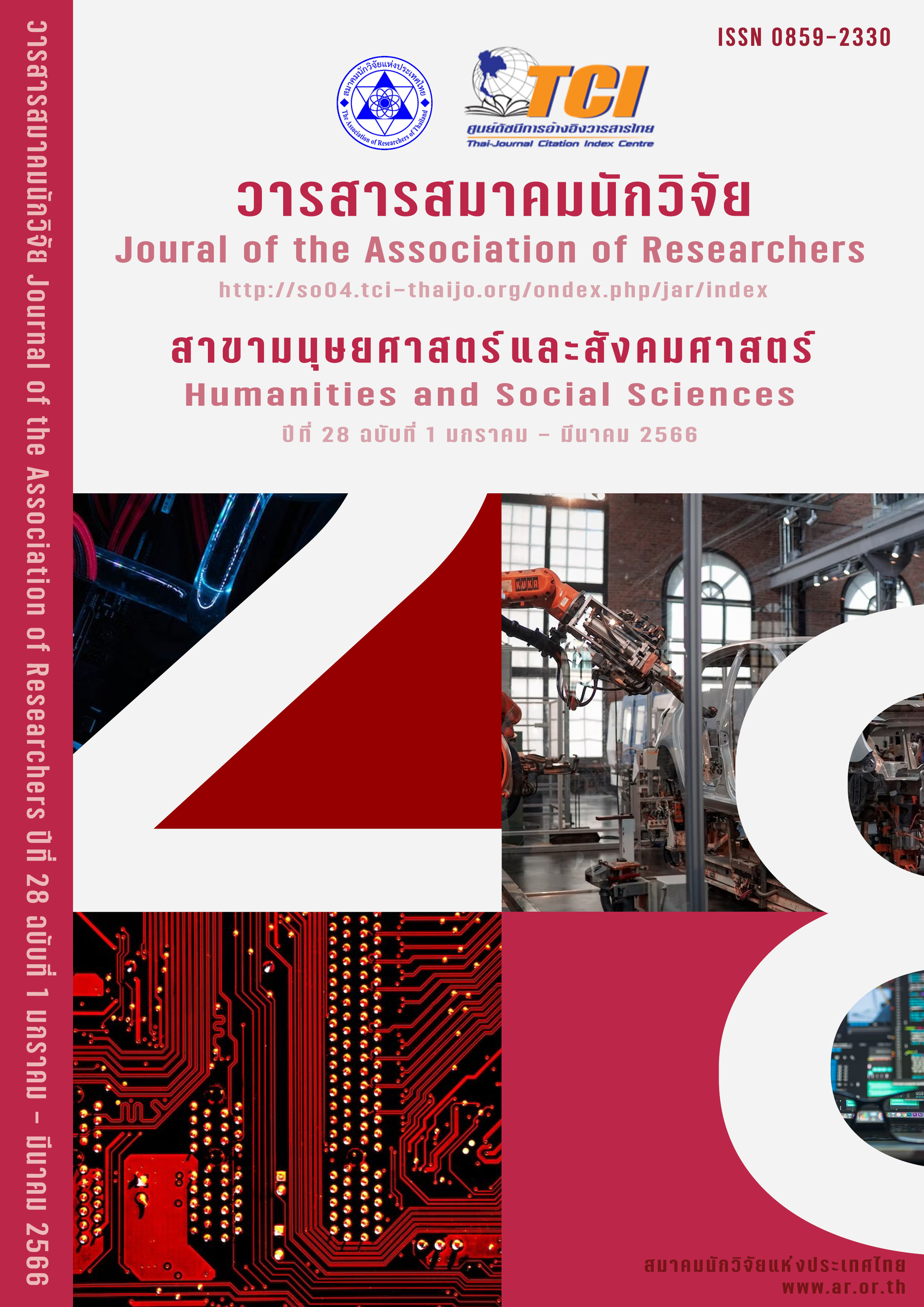Work Competencies of Bachelors in Food Science and Technology and Higher Education Development Guidelines for the Needs of Graduate Users in Northern Thailand
Main Article Content
Abstract
hailand plans to develop the food processing industry (2019-2037), focusing on future food innovation and workplace readiness personnel. Human resource capacity is critical to driving the development plan. The objective of this study was to explore and identify work competencies of food science and technology and provide an improvement guideline on work abilities to reach the needs of employers in northern Thailand. The research methodology was the quantitative method by an employment survey from 98 respondents in 8 northern provinces. The respondents work for food companies, research centers and laboratories, educational institutes, and hospitals. The northern region survey collected data from paper-based questionnaires sent by mail. Data analysis was carried out by using descriptive statistics, frequency, percentage, standard deviation, and the Chi-square. The results were found as follows; 1) food control/quality assurance and food supervision are the most important performance requirements in the field of food science and technology. The major competencies are positivity and working well with others, followed by application of the wider world, data management, getting the job done and tackling problems, innovation and inquiry, dependability, and the business world. The new finding was a statistical relationship between the two food science performances and the work competencies at 0.05 significance. 2) most employers would collaborate short-term courses with higher education to develop new skills, including foreign languages and digital skills for current students and alumni in creating a food business atmosphere via lifelong learning in 21st century.
Article Details

This work is licensed under a Creative Commons Attribution-NonCommercial-NoDerivatives 4.0 International License.
บทความที่ปรากฏในวารสารนี้ เป็นความรับผิดชอบของผู้เขียน ซึ่งสมาคมนักวิจัยไม่จำเป็นต้องเห็นด้วยเสมอไป การนำเสนอผลงานวิจัยและบทความในวารสารนี้ไปเผยแพร่สามารถกระทำได้ โดยระบุแหล่งอ้างอิงจาก "วารสารสมาคมนักวิจัย"
References
เจษฎา กิตติสุนทร และ วาสนา กีรติจำเริญ. (2560). การศึกษาทักษะการเรียนรู้ในศตวรรษที่ 21 ของนักศึกษารายวิชา การพัฒนาหลักสูตรตามรูปแบบ Big Five Learning. วารสารชุมชนวิจัย. เมษายน, 11(1): 103-112.
ฐานเศรษฐกิจ. (2559). ดัน 4 จังหวัดภาคเหนือตอนบน สู่ศูนย์กลางอุตสาหกรรมอาหารแปรรูปภูมิภาคอาเซียน.สืบค้นจาก https://www.baania.com/article (12 ธันวาคม 2559)
ไทยโพสต์. (2565). 'สุริยะ' ดันส่งออกอาหารแปรรูปไทยลุ้นปี 65 มูลค่า 6 แสนล้าน. สืบค้นจาก https://www.thaipost.net/economy-news/165039/ (20 มิถุนายน 2565)
นักสิทธิ์ ปัญโญใหญ่, สุพจน์ บุญแรง, วิศนี สุประดิษฐอาภรณ์, อภิรดา พรปัณณวิชญ์, และ ปิลันธสุทธิ์ สุวรรณเลิศ. (2565). “หลักการ 5P สู่ 4เป็น” เพื่อพัฒนานักศึกษาที่มีความเป็นผู้ประกอบการด้านผลิตภัณฑ์อาหารเชิงสร้างสรรค์. วารสารการเกษตรราชภัฏ, มิถุนายน, 21(1): 1-9.
นักสิทธิ์ ปัญโญใหญ่. (2564). การศึกษาอาหารในประเทศไทยไปสู่ฐานวิถีชีวิตใหม่. พิฆเนศวร์สาร. ธันวาคม, 17(2): 15-27.
สถาบันเทคโนโลยีพระจอมเกล้าเจ้าคุณทหารลาดกระบัง. (2565). Food skill mapping. สืบค้นจาก https://skill.kmitl.ac.th/charts (5 พฤษภาคม 2565)
Bohlscheid, J. and Clark, S. (2016). Carrere preparedness survey outcomes of food science graduates- a follow-up assessment. Journal of Food Science and Education. April, 11: pp. 8-15.
Flynn, K., Wahnstrom, E., Popa, M., Ruiz-Bejarano, B. and Quintas, M. A. C. (2013). Ideal skill for European food scientists and technologists: Identifying the most desired knowledge, skills, and competencies. Innovative Food Science and Emerging Technologies. April, 18: pp. 246-255.
Hartel, R. W.. (2002). Core competencies in food science: Background information on the development of the IFT education standards. Journal of Food Science and Education. April, 1: pp. 1-5.
LeGrand, K., Yamashita, L., Trexler, C. J., Vu, T. L. A., Yang, G. M. (2017). Developing food science core competencies in Vietnam: The role of experience and problem-solving in an industry-based undergraduate research course. Journal of Food Science and Education. November, 16(4): pp. 118-130.
Metcafe, D. J. A., Fourie, C. M. and Myburgh, C. P. M. (2020). Graduate capabilities required of South African food science and technology students. Journal of Food Science and Education. February, 19: pp. 85-96.
Morgan, M. T., Ismail, B. and Hayes, K. (2006). The relative importance of the Institute of Food Technologists (IFT) core competencies-A case study survey. Journal of Food Science and Education. September, 5: pp. 35-39.
Weston, E., Crilly, J., M., Mossop, L., and Faster, T. (2017). Competencies for food graduate carriers: developing a language tool. Higher Education Pedagogies. August, 2: pp. 101-115
Weston, E., Benlloch-Tinoco, M., Mossop, L., McCullough, F., and Faster, T. (2020). Curriculum mapping food science programs: An approach to quantification of professional competencies. Journal of Food Science and Education. March, 19: pp. 97-108.
Weston, E., Foster, T., Crilly, J., and Mossop, L. (2019). Development of a professional competency framework for UK food science graduates. Journal of Food Science and Education. December, 19: pp. 10-25.
Translated Thai References
Kittisuntorn, Chedsada and Keeratichamroen, Wassana, (2017). A study of 21st-century learning skills of undergrads students on curriculum development courses using big five learning. NRRU Community Research Journal. April, 11(1): pp. 103-112. (in Thai).
King Mongkut's Institute of Technology Ladkrabang. (2022). Food skill mapping. Retrieved from https://skill.kmitl.ac.th/charts (May, 5, 2022). (in Thai).
Panyoyai, Naksit. (2021). Food education in Thailand towards new normal. Phikantesan. December, 17(2): pp. 15-27. (in Thai).
Panyoyai, Naksit, Boonraeng, Supot, Supraditareporn, Wissanee, Phonpannawit, Apirada, and Suwannalert, Pilunthasut (2022). The guideline for the management of food science and technology curriculum with “5Ps to abilities principle” to develop internarial students in creative food products. Rajabhat Agriculture Journal, June, 21(1): 1-9. (in Thai).
Thai Post. (2022). “Suriya” pushes Thai processed food exports in 2022 worth 600 billion.Retrieved from https://www.thaipost.net/economy-news/165039/(June, 20, 2022). (in Thai).
Than Settakij. (2016). Pushing 4 provinces in the upper northern region towards the center of food processing industry in ASEAN region.
Retrieved from https://www.baania. com/article (December, 12, 2022). (in Thai).


